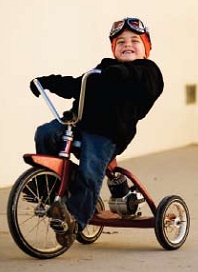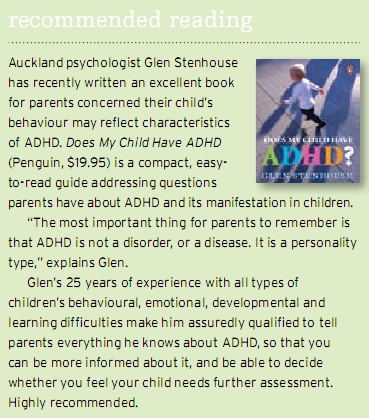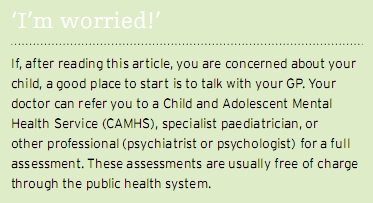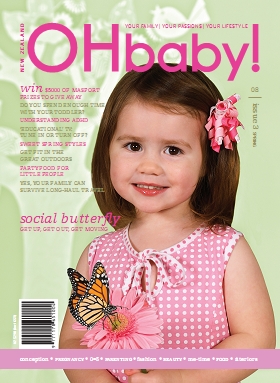Understanding ADHD

No matter what age your child is, no doubt you've heard
of ADHD - and at some point, you may even have wondered if your own
child is exhibiting ADHD-like symptoms. But what is ADHD, and how
can you tell if your child has it? Isn't ADHD just an overused,
catch-all term for children who need better discipline anyway?
Child and adolescent clinical psychologist Dr Melanie Woodfield
addresses some common myths and misconceptions about ADHD.
Attention-Deficit/Hyperactivity Disorder (ADHD) is a very
hot topic nowadays. You may have gathered this from the number of
times it's mentioned in the media, or how often you hear people
casually saying things such as, "He's so full-on! I wonder if he's
'ADD'?" A quick search of one well-regarded research database
identified over 11,000 articles related to ADHD, with approximately
350 published in 2008 alone. Even more impressive, Google returns
34.5 million hits!
Despite the huge amount of scientific
research into the causes, assessment and treatment of ADHD, there
is still a significant amount of misunderstanding in the
community. The research doesn't seem to spread beyond the journals,
and instead, myths are often perpetuated by word of mouth. The
purpose of this article is to outline some of these common myths,
and hopefully share some things you didn't know (and always wanted
to know!) about this relatively common condition.
How is ADHD diagnosed?
First things first: We ought to understand how ADHD is diagnosed.
The diagnostic criteria for mental health issues in New
Zealand (along with much of the world) are found in the
Diagnostic and Statistical Manual of Mental Disorders, or DSM
for short. The DSM is reviewed regularly, with occasional revisions
being made to diagnostic criteria based on research that has
occurred since the last revision. The current edition is DSM-IV-TR
(Fourth edition, Text Revision), and the DSM-V (Fifth edition) is
due for release in 2012.
In a nutshell, according to DSM-IV-TR
criteria, children need to display six or more symptoms of
inattention (e.g. being easily distracted, forgetful, having
trouble sustaining attention) and/or hyperactivity-impulsivity
(e.g. fidgeting, running about or climbing excessively, often
talking excessively or blurting out answers and interrupting
others) for at least six months "to a degree that is
maladaptive and inconsistent with developmental level". In other
words, while we'd expect several of these behaviours from the
average two-year-old, we'd expect fewer from a four or
five-year-old. These symptoms need to be present in two or more
settings (e.g. home, Nana's house, and kindy), and need to result
in "clinically significant impairment" - if these symptoms aren't a
problem for you or your child, then your child doesn't meet
criteria for the diagnosis. The final point to note is that some of
the above symptoms need to have been present before age seven, to a
degree that "caused impairment", not just inconveniences.
These criteria may be a surprise in
themselves - many people assume that almost all children can be
diagnosed with ADHD, when in fact the criteria are very carefully
considered, and relatively tight. For example, while many children
under five will show inattentive and/or overactive behaviour, very
few children will continue to display these behaviours to the same
degree for longer than six months.
 Common myths about
ADHD
Common myths about
ADHD
Myth: "All hyperactive kids have
ADHD."
Fact: Most children have periods of
time where they are hyperactive and/or impulsive. In
fact, the activity levels of children (and adults) can be thought
of as varying on a continuum, from those children who are hardly
ever hyperactive or impulsive, to those children who are often
hyperactive and impulsive. Most diagnoses, particularly in the area
of mental health, are simply a way of drawing "a line in the
sand" on that continuum according to well-researched criteria. On
one side of the line, we have children with "normal" activity
levels (or activity levels common to most children), and on the
other side, those children with "abnormal" levels (or activity
levels that are far less common statistically). As mentioned
earlier, several other criteria need to be met, over and above
being "hyper", for a child to be diagnosed with ADHD.
So, it is very possible to be boisterous,
but not meet the criteria for ADHD. And, just to complicate things,
another common myth...

Myth:"All kids with
ADHD are 'hyper'."
Fact: We've all seen the stereotypes
of children with ADHD - the kids who are always on the go,
butting in, constantly running, jumping, and demanding attention.
This type of presentation can describe a child with ADHD. But did
you know that there are other types of ADHD? According to
DSM-IV-TR, there are three subtypes of ADHD:
• ADHD, Predominantly Hyperactive-Impulsive
Type. This is the "stereotypical" ADHD.
• ADHD, Predominantly Inattentive Type.
Hyperactivity symptoms are not present with this subtype. This
subtype is often under-diagnosed, as children tend to present as
distracted or daydreaming, unfocused, and inattentive. These
children are not "climbing the walls", present less of a problem
for parents/carers/teachers, and so are often not identified as
readily as other children with ADHD. Sometimes parents refer to
this as "ADD"; that is, ADHD without the hyperactivity
component.
• ADHD, Combined Type. Both inattention and
hyperactivity/impulsivity symptoms are present.
So, it is very possible to not be hyperactive, and still meet
criteria for ADHD (predominantly inattentive type).
Myth:"It seems
like everyone has ADHD these days. It didn't even exist in my
parents' day!"
Fact: While ADHD is one of the more
common childhood mental health issues, it is still relatively rare
compared to many physical health issues such as asthma, obesity or
diabetes. The DSM-IV-TR estimates that ADHD affects between 3-5% of
children.
Chances are, ADHD did exist in your
parents' day - it was just known as something different. Various
diagnoses or conditions that are basically the same as what we now
know as ADHD have been identified for almost a century. The term
ADHD was first used in the DSM approximately 25 years ago.
The other aspect to this myth is the
unspoken doubt about the validity of the diagnosis itself. ADHD has
received much attention in the media over the last decade in
particular, portraying both accurate and inaccurate information.
In 2002, a collection of over 75 world-renowned
researchers and practitioners felt so strongly about the
unhelpful media attention regarding ADHD that they
published a "Consensus Statement on ADHD" in the European Child
& Adolescent Psychiatry Journal.
The statement began, "We, the undersigned
consortium of international scientists, are deeply concerned about
the periodic inaccurate portrayal of attention deficit
hyperactivity disorder (ADHD) in media reports... We fear that
inaccurate stories rendering ADHD as myth, fraud, or benign
condition may cause thousands of sufferers not to seek treatment
for their disorder. It also leaves the public with a general sense
that this disorder is not valid or real or consists of a rather
trivial afliction."
The authors go on to emphasise that, "The
US Surgeon General, the American Medical Association (AMA), the
American Psychiatric Association, the American Academy of Child and
Adolescent Psychiatry (AACAP), the American Psychological
Association, and the American Academy of Pediatrics (AAP), among
others, all recognise ADHD as a valid disorder."
A pretty powerful endorsement! The authors
go on to summarise that "as a matter of science, the notion that
ADHD does not exist is simply wrong. All of the major medical
associations and government health agencies recognise ADHD as a
genuine disorder because the scientific evidence indicating it is
so overwhelming." What more can we
say?
Myth: "Kids with supposed ADHD have just had too
much sugar and no boundaries at home."
Fact: Although many parents assume
that sugar causes hyperactivity, there is very little
research-based evidence to support this (although some food
additives have been associated with hyperactivity - see my article
"A Spoonful of Sugar" in Issue 1 of OHbaby! Magazine). While there
is sometimes a link between lots of sugar and children being
hyperactive (picture those birthday parties!), the research shows
it's more likely to be a result of other factors (such as the
party/celebration context in which the sugar is given) that
encourages hyperactivity - not the sugar itself causing the
hyperactivity. Of course, that's not to say that children having
lots of sugar is a good thing!
Regarding the "no boundaries" notion:
Parents putting in place consistent and sensible boundaries and
consequences for children (and, very importantly, consistent and
sensible praise or other rewards for appropriate behaviour) is very
helpful for all children. This includes children with ADHD, who
usually respond very well to a structured approach to behavioural
expectations of them. But, while poor boundaries may
exacerbate the difficulties that a child with ADHD faces, they
don't cause ADHD in and of themselves.
Myth:"If my child is diagnosed with ADHD,
I'll have to give him/her Ritalin, and I've heard bad things about
it."
Fact: Ritalin and other medication
used to treat ADHD have received a lot of media attention, often
not favourable. These medicines have even been referred to as
"kiddie cocaine", which is completely misleading, and a good
reminder to be very vigilant about the source of any information
you read. If you Google "Ritalin", you're likely to bring up a
mixed bag of both biased and independent information, and
determining the difference can be very difficult!
Fortunately, there has also been a lot of
research in reputable journals - the Journal of the American
Academy of Child and Adolescent Psychiatry published a review of
the use of stimulant medication (such as Ritalin) for children, in
which the authors noted that "studies of the short-term benefits of
stimulants on the symptoms of ADHD constitute the largest body of
treatment literature of any childhood onset psychiatric
disorder."
In short, Ritalin (and other similar
medications) usually work, and work well, without long-term
side-effects. Psychologists are often seen to be "anti-medication",
but there really is no denying the abundant collection of research
into how effective this medication is in improving the core ADHD
symptoms in most children with ADHD. However, as a parent, you
would never be forced or required to medicate your child for
ADHD, and you should always be provided with full and complete
information about the benefits and side-effects of any medication,
including Ritalin.
Assessing ADHD
Before even considering the issue of medication, you and your child
would participate in a thorough assessment for ADHD. If your
child met the criteria, you would then usually be provided with
several treatment options, one of which might be treatment with
stimulant medication.
These days, there are several medications
subsidised by the New Zealand government, which suit different
children in different circumstances. The other point to note is
that using medication doesn't have to be an "all or nothing"
decision - many parents choose to medicate their child for kindy
or school, and not in the evenings and weekends, or have
regular "medication holidays".
Also, while medication may treat the core
symptoms of ADHD, other issues, such as social skills problems,
oppositional behaviour, and aggression are often best treated
with a combination of medication and other interventions
(such as social skills training, parent education, behavioural
training, or family therapy).
You may be interested to learn that, in New
Zealand, dexamphetamine and methylphenidate (Ritalin), both used to
treat ADHD, are known as controlled drugs, and can only be
prescribed by specialist Paediatricians or Psychiatrists. Your GP
can only prescribe these medicines when acting on the
recommendation of one of these professionals. This is to further
monitor and control the prescription of these medications, and
ensure that they are prescribed carefully and
responsibly.

Dr Melanie Woodfield is a child and adolescent
clinical psychologist. She lives in Auckland with her husband and
two young boys.
References
• American Academy of Child and Adolescent
Psychiatry. "Practice
parameters for the use of stimulant medications in the treatment of
children, adolescents and adults." Journal of the American
Academy of Child and Adolescent Psychiatry 41.2 (2002).
• Barkley, RA et al. "Consensus Statement on ADHD." European
Child & Adolescent Psychiatry 11 (2002): 96-98.
For further
information
• "New Zealand Guidelines for the Assessment and Treatment of
Attention-Deficit/Hyperactivity Disorder." Published by the
Ministry of Health (2001) and available for download from www.moh.govt.nz
• The NZ ADHD online support group www.adhd.org.nz
• Children and Adults with Attention Deicit/Hyperactivity
Disorder (American website) www.chadd.org
As seen in OHbaby!
magazine Issue 3: 2008

Subscribe to OHbaby!
magazine
Purchase Issue 3

